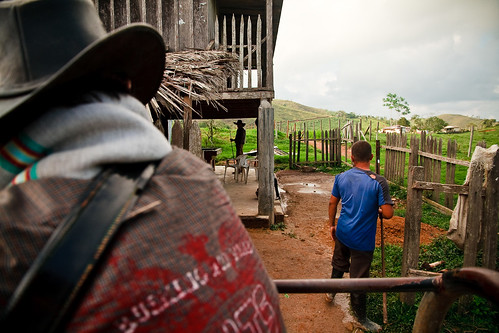sábado 25 de septiembre, 2010
d.27
__delhi, india
En India reencontré a Raghu Rai, el mejor fotógrafo indio.
Su trabajo es impresionante.
es mi maestro.
pueden ver un poco acá:
y acá
aunque su trabajo no suele ser autorreferencial, esta foto me llega al alma:
se llama:
My Father and My Son, 1969
* * *
Master class con Raghu Rai
Llegué justo a tiempo y antes de entrar al auditorio lo reconocí en un salón. Estaba con otros 3 que al parecer le hacían una entrevista privada. Me asomé y me aseguré que me viera y que viera mi camisa.
Entré al auditorio y cogí una silla en primera fila, justo frente al lugar donde él se sentaría. Me quité las sandalias y me crucé de piernas. Alisté la grabadora. Entró. Es grande, alto. A pesar de ser viejo, se ve muy fuerte, bien conservado. Como buen Indio, se tiñe el pelo, pero no tan naranja como los que usan gena natural, un poco más café. Se podría decir que es feo, pero su actitud lo hace atractivo. Durante 3 horas lo escuché hablar sobre fotografía. Nos mostró fotos, desde la primera que tomó en blanco y negro, hasta las últimas que ha tomado en color. Hizo ejercicios con estas últimas para que viéramos las diferencias de tenerlas en color o en blanco y negro.
Le hice un retrato en tres cuadros:
ver en negro / view on black
Muy generoso, claro, sencillo.
Hubo algunas cosas que dijo que yo ya había pensado, pero las puso en mejor manera:
Hay que salir de la 'confort zone', porque no hay atajos para la creatividad: work, explore. En palabras de alguien (que no cogí el nombre): 'those who are not living on the edge are wasting space'
Don't reproduce pictures that you've seen before.
Explorer vs. copyist.
'When you become an explorer (Humboldt) life changes'.
Connect with your subject, with the situation, with thew divine, with magic, and it will just happen. (Give it time). Don't plan, nature is gifting. Divine energy is limitless. It's us humans that invented god, don't forget that, so we can do anything.
Don't look like a pro.
Be quick.
Less mental, more heart (spirit). Voy a ensayar a cambiar de ojo. When it's mental, you repeat the same info you already have. Don't make a good (and repeated) photo: better to make a great mistake.
Stop eating fast (mental) food.
Find silence in the meaningless thing, they are worth more than a thousand words.
Look for things that energizes the frame. Tension. Charge.
Colors: look the more natural possible.
Y otras que no sabía:
Nothing is pretty. Don't make pictures of pretty things or you are not doing nothing. Energize the frame.
When too much things are happening it might work better b&w.
Cuando llega a un lugar a hacer fotografías, primero se conecta con la situación: entrelaza las manos para que fluya la energía.
Fly into the sky and:
1. Don't fall on somebodies elses footsteps.
2. Don't fall on you own footsteps.
Trabaja con:
Mack II 5d
canon 550d con zoom para fiestas y amigos.
Dio un secreto para las fotos de lluvia: sobreexponer.
'The ultimate guru is sitting in each one of us.'
Al final la gente no paraba de hacer preguntas. Dijeron 'two more questions'. Yo no podía no hablar. Esta vez si era ahora o nunca. Alcé la mano. Yo sabía que él ya me había notado. La señora del micrófono me miró como diciendo 'no, hay muchos con la mano alzada antes' pero él me miró y me señaló:
'Un fotógrafo joven como yo, que siente que tiene un buen trabajo, y quiere compartirlo con el mundo, ¿qué opciones tiene?'
'Today there's lots of galleries, you should go and someone might get interested'.
Al final lo rodearon a pedirle autógrafos (yo decidí no llevar el libro, la firma no era lo valioso para mí), a tomarse fotos con él, a hacerle preguntas. Cuando lo tuve cerca le dijo a una niña 'last question'. Y pensé que estaba cansado. Él se había percatado de mi prescencia, y me puse nervioso y me alejé. Pensé preguntarle a su asistente, decirle que no quería molestar al maestro, que si podía enviarle fotos y si él consideraba que se las mostrara al duro. Pero no podía perder la oportunidad y la gente seguía preguntándole. Así que decidí acercarme por segunda vez. Cuando lo tuve en frente sentí que me decía con la mirada: 'qué o qué o que'. Yo había planeado mil discursos, pero sabía que era un error enredar la pita y afortunadamente los nervioso me hicieron ir al grano:
'Mr. Raghu Rai, I'd like to introduce myself: I'm Nicolas from Colombia and I'm very committed to photography. I would like to share my work with you.'
'Of course'. Y llamó al asistente y le dijo que me diera el teléfono. Mi libreta 'storage.it', esfero a la mano, y anoté el teléfono. Increíble.
Ahora viene la segunda parte de la historia que por hoy queda en continuará.
pueden ver un poco acá:
y acá








